Search Result
Results for "
stomach
" in MedChemExpress (MCE) Product Catalog:
5
Biochemical Assay Reagents
6
Isotope-Labeled Compounds
| Cat. No. |
Product Name |
Target |
Research Areas |
Chemical Structure |
-
- HY-B1132
-
|
Ro 2-3773
|
mAChR
|
Neurological Disease
|
|
Clidinium bromide is a quaternary amine antimuscarinic agent. Clidinium bromide may help symptoms of cramping and abdominal/stomach pain by decreasing stomach acid, and slowing the intestines in vivo .
|
-

-
- HY-N0671
-
|
Rhaponiticin
|
Apoptosis
|
Cancer
|
|
Rhapontin (Rhaponiticin), a component of rhubarb (Rheum officinale Baill), induces apoptosis resulting in suppression of proliferation of human stomach cancer KATO III cells .
|
-
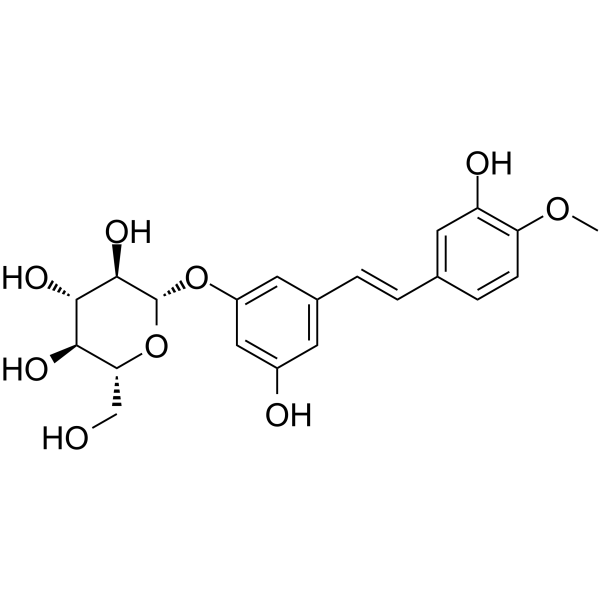
-
- HY-P1635
-
|
EC 3.4.23.1
|
Endogenous Metabolite
|
Endocrinology
|
|
Pepsin is the major pig and human gastric proteases, it is a pepsin-like minor gastric proteolytic enzymes. Pepsin contributes to proteolysis of food proteins in the vertebrate stomach .
|
-

-
- HY-B0310
-
|
|
Histamine Receptor
|
Inflammation/Immunology
Endocrinology
Cancer
|
|
Nizatidine is a potent and orally active histamine H2 receptor antagonist, can be used for the research of stomach and intestines ulcers. Nizatidine works by decreasing the secretion of gastric acid the stomach makes and prevent ulcers from coming back after they have healed in animal models .
|
-
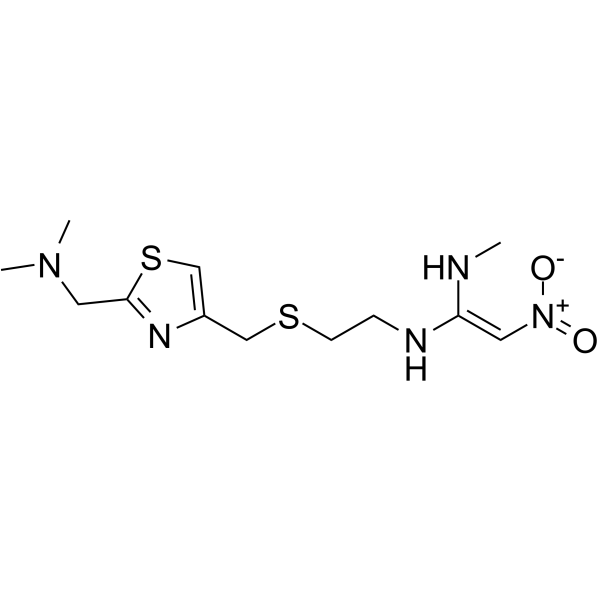
-
- HY-E70077
-
|
|
Endogenous Metabolite
|
Infection
Metabolic Disease
|
|
Penicillinase (from calf stomach) is an enzyme that degrades penicillin by hydrolyzing the cyclic amide bonds in the lactam ring of penicillin, which can inactivate penicillin. Penicillinase (from calf stomach) can be isolated from penicillin resistant strains. Penicillinase (from calf stomach) has potential application as a marker for steroid hormone enzyme linked immunosorbent assay .
|
-

-
- HY-12204
-
PFK-015
3 Publications Verification
|
Autophagy
|
Metabolic Disease
Inflammation/Immunology
Cancer
|
|
PFK-015, a derivative of 3PO, is a specific PFKFB3 inhibitor. PFK-015 inhibits recombinant PFKFB3 with an IC50 value of 110 nM and inhibits PFKFB3 activity in cancer cells with an IC50 value of 20 nM. PFK-015 can be used for the research of multiple cancers such as lung cancer, stomach cancer, colon cancer and esophageal squamous cell carcinoma (ESCC) .
|
-

-
- HY-N0925
-
|
Canadine
|
Dopamine Receptor
|
Neurological Disease
|
|
Tetrahydroberberine is a different kind of living thing that can be extended and divided into parts. Tetrahydroberberine is a kind of effective D2 receptor antagonistic force. Tetrahydroberberine has the ability to strengthen the stomach and relieve the pressure on the stomach .
|
-

-
- HY-B0310S
-
|
|
Histamine Receptor
|
Inflammation/Immunology
Endocrinology
Cancer
|
|
Nizatidine-d3 is the deuterium labeled Nizatidine. Nizatidine is a potent and orally active histamine H2 receptor antagonist, can be used for the research of stomach and intestines ulcers. Nizatidine works by decreasing the secretion of gastric acid the stomach makes and prevent ulcers from coming back after they have healed in animal models[1].
|
-

-
- HY-W251598C
-
|
Sodium hydrogen carbonate for cell culture; Soda bicarbonate for cell culture
|
Biochemical Assay Reagents
|
Others
|
|
Sodium bicarbonate, for cell culture, an inorganic salt, is neutral to slightly alkaline. And it is susceptible to moisture and decomposition in the air. Sodium bicarbonate is widely used in food, pharmaceutical, cosmetics and other fields, the main uses include buffer, seasoning, disinfectant, pharmaceutical and proton gradient regulator. Sodium bicarbonate is also commonly used as an antacid to suppress gastrointestinal disorders, neutralize stomach acid and reduce stomach discomfort.
|
-
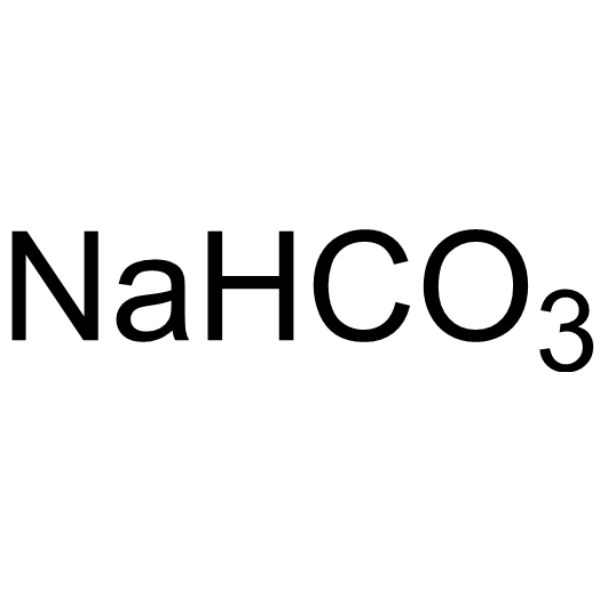
-
- HY-P2810
-
|
EC 3.4.23.4
|
Endogenous Metabolite
Ser/Thr Protease
|
Metabolic Disease
|
|
Rennin, also known as Chymosin, is a pepsin-related proteolytic enzyme synthesized by cells in the stomach of certain animals that efficiently converts liquid milk into a semi-solid, allowing it to remain in the stomach for longer. The natural substrate of Rennin is K-casein, which is specifically cleaved at the peptide bond between amino acid residues 105 and 106, phenylalanine and methionine, and is widely used in cheese production .
|
-

-
- HY-P1097
-
-

-
- HY-13662S
-
-
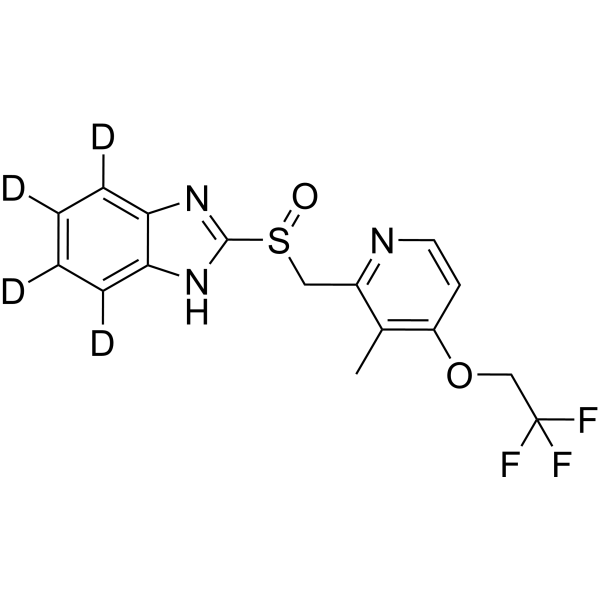
-
- HY-Y1876
-
|
|
Others
|
Others
|
|
Guaiacol Carbonate acts as an expectorant by virtue of a reflex from the stomach by way of the afferent gastric nerves to the medullary centres and thenperipherally again to the respiratory tract .
|
-
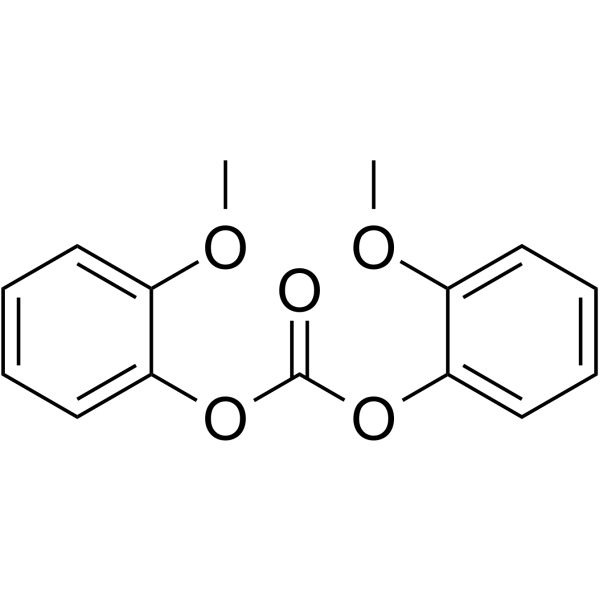
-
- HY-N12121
-
|
|
Others
|
Infection
Inflammation/Immunology
|
|
Piperundecalidine is an amide alkaloids that can be purified from Piper longum L. Piperundecalidine shows various biological properties, such as anti-inammatory, analgesic, anti-amoebic, anti-depressant, hepatoprotective,etc. .
|
-
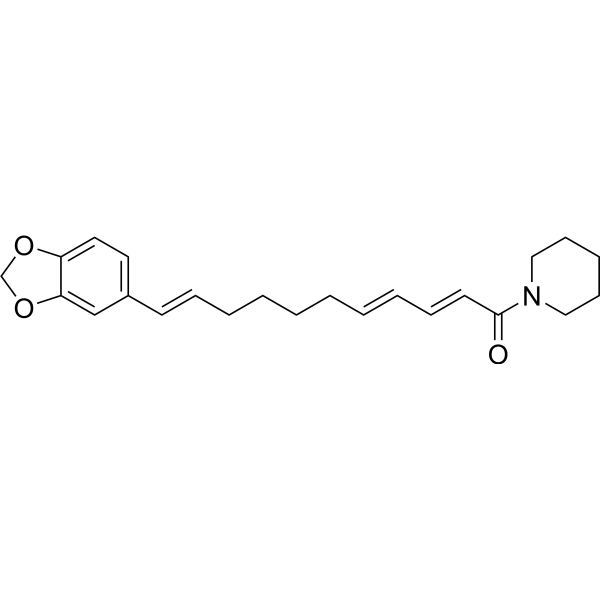
-
- HY-N9183
-
|
|
Others
|
Inflammation/Immunology
|
|
Diarylcomosol III, a diarylheptanoid, can be isolated from dried rhizomes of Curcuma comosa. The rhizome of Curcuma comosa has aromatic stomachic and anti-inflammatory activity .
|
-

-
- HY-Y0756
-
|
Sodium hydrogen carbonate
|
Biochemical Assay Reagents
|
Others
|
|
Sodium bicarbonate, also known as baking soda, sodium bicarbonate, or sodium bicarbonate, is neutral to slightly alkaline. And it is susceptible to moisture and decomposition in the air. Sodium bicarbonate is widely used in food, pharmaceutical, cosmetics and other fields, the main uses include buffer, seasoning, disinfectant, pharmaceutical and proton gradient regulator. In the food industry, it is often used as a flour starter or leavening agent to make food swell up and become softer. Sodium bicarbonate is also commonly used as an antacid to suppress gastrointestinal disorders, neutralize stomach acid and reduce stomach discomfort.
|
-
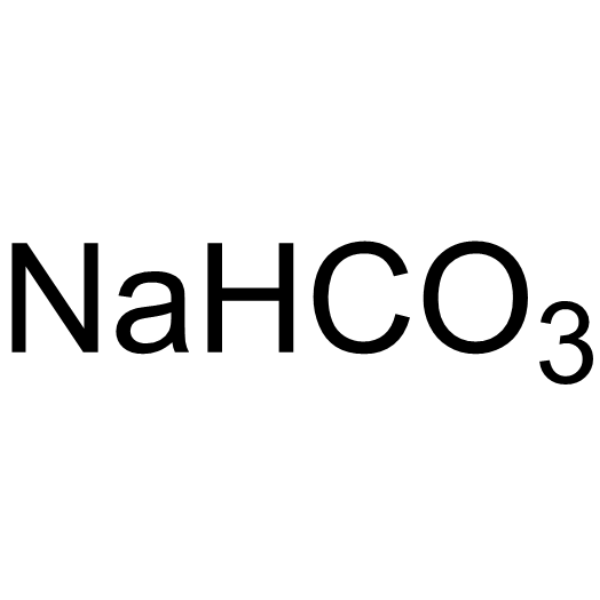
-
- HY-B1188S
-
|
|
mAChR
|
Neurological Disease
|
|
Propantheline-d3 (bromide) is the deuterium labeled Propantheline bromide. Propantheline bromide is an antimuscarinic agent, used for the treatment of hyperhidrosis, cramps or spasms of the stomach, intestines or bladder, and enuresis.
|
-
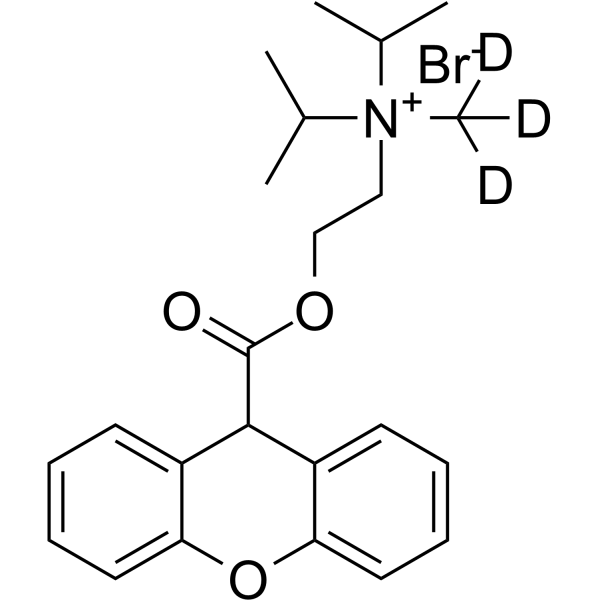
-
- HY-100412
-
|
AZD0865
|
Proton Pump
|
Cancer
|
|
Linaprazan (AZD0865) can inhibit H+,K+ -ATPase in the stomach through K+ competitive binding. (IC 50: 1.0 ± 0.2 μM), it has a strong inhibitory effect on acid.
|
-
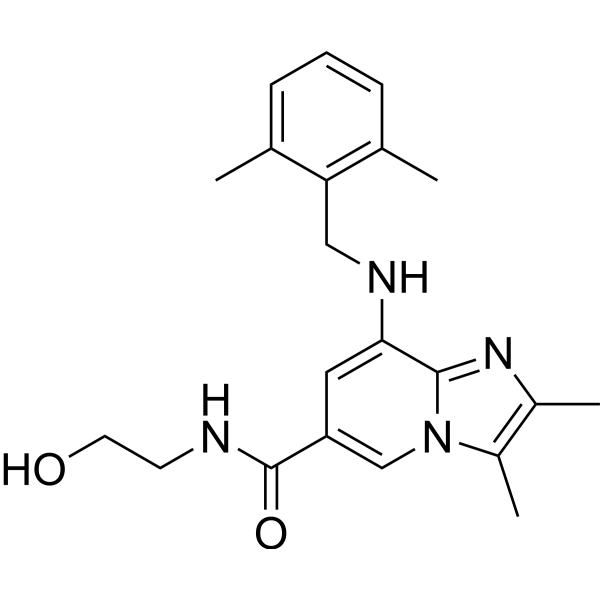
-
- HY-B1188A
-
|
|
|
|
|
Propantheline is an orally active mAChR antagonist. Propantheline can be used in the research of smooth muscle dysfunction, excessive sweating, cramps or spasms of the stomach, intestines or bladder, and involuntary urination .
|
-

-
- HY-E70198
-
|
EC 3.4.23.1 (MS Grade)
|
Endogenous Metabolite
|
Others
|
|
Pepsin (MS Grade) is the major pig and human gastric proteases, it is a pepsin-like minor gastric proteolytic enzymes. Pepsin (MS Grade) contributes to proteolysis of food proteins in the vertebrate stomach .
|
-
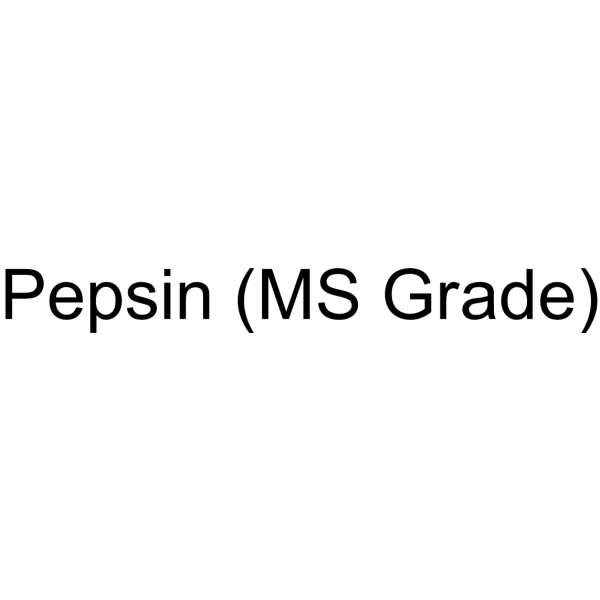
-
- HY-B1188
-
|
|
mAChR
|
Neurological Disease
|
|
Propantheline bromide is an orally active mAChR antagonist. Propantheline bromide can be used in the research of smooth muscle dysfunction, excessive sweating, cramps or spasms of the stomach, intestines or bladder, and involuntary urination .
|
-
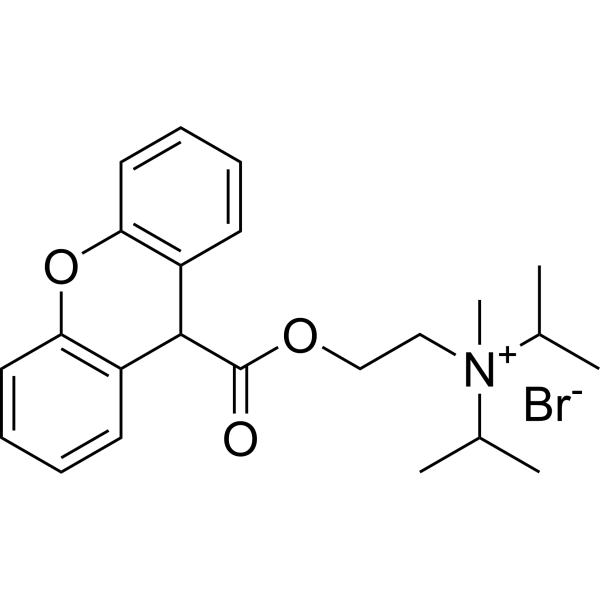
-
- HY-13662
-
-
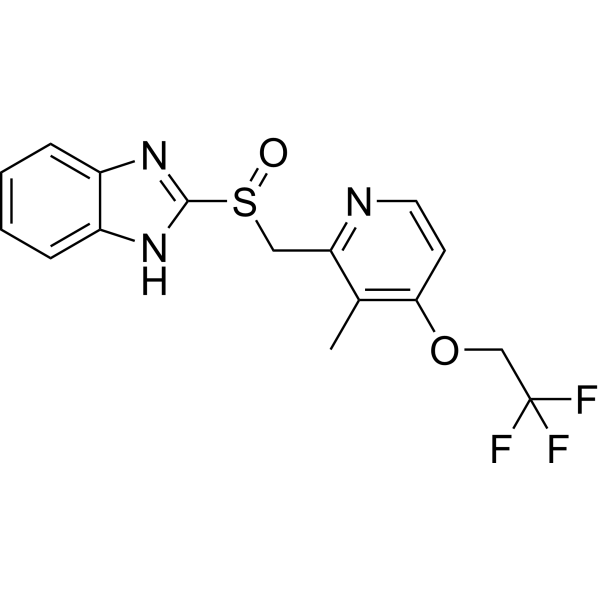
-
- HY-B0411
-
|
R33812
|
Dopamine Receptor
|
Neurological Disease
|
|
Domperidone (R33812) is an orally active and selective dopamine-2 receptor antagonist. Domperidone acts as an antiemetic and a prokinetic agent through its effects on the chemoreceptor trigger zone and motor function of the stomach and small intestine .
|
-

-
- HY-129471
-
|
|
Endogenous Metabolite
|
Inflammation/Immunology
|
|
Arbaprostil is an orally active PGE1 (HY-B0131) analog. Arbaprostil protects the gastrointestinal mucosa from stomach acid and other irritants, promotes healing rate of gastric ucler through the antisecretory effect .
|
-
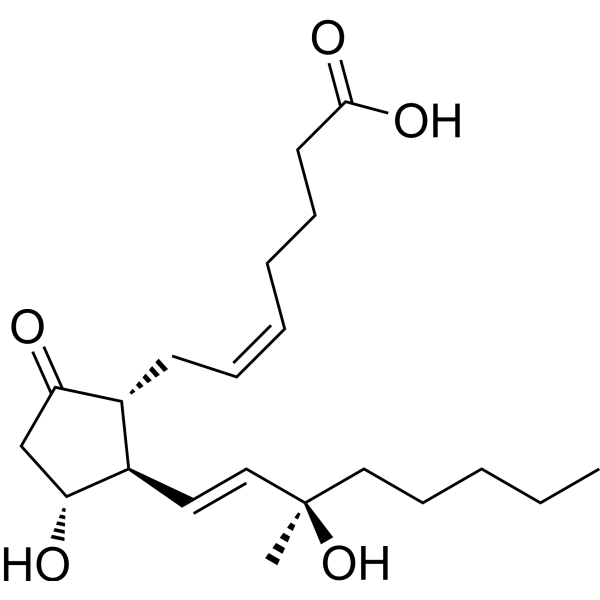
-
- HY-B1984
-
|
4,4'-DDD; p,p'-Dichlorodiphenyl dichloroethane
|
|
|
|
p,p'-DDD is a major metabolite of p,p'-DDT. p,p'-DDD occurs in the feces and livers of rats, that are given p,p'-DDT by stomach tube, but not of rats injected intraperitoneally with p,p'-DDT .
|
-
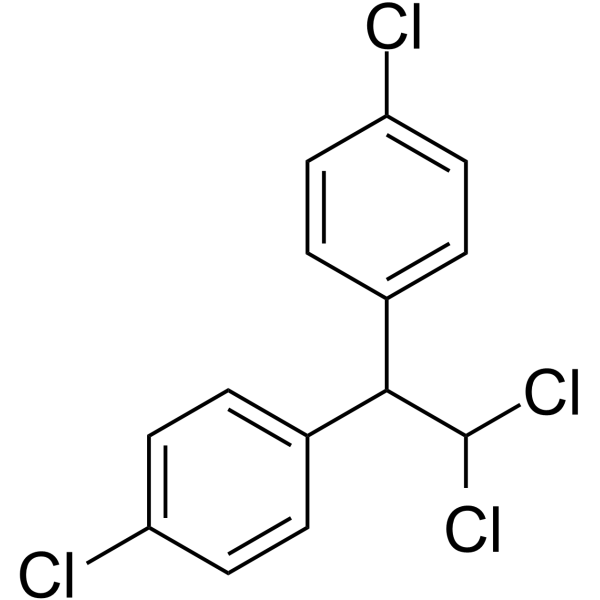
-
- HY-N1219
-
|
(-)-Stephanine; l-Stephanine
|
|
|
|
Stephanine ((-)-Stephanine) is an isoquinoline aporphine-type alkaloid. Stephanine induce apoptosis through the reverse of mitotic exit. Stephanine exhibits Antiplasmodial activity. Stephanine can be used for the research of stomach pain, abdominal pain, arthritis and cancer .
|
-

-
- HY-N0671R
-
|
Rhaponiticin (Standard)
|
Apoptosis
|
Cancer
|
|
Rhapontin (Standard) is the analytical standard of Rhapontin. This product is intended for research and analytical applications. Rhapontin (Rhaponiticin), a component of rhubarb (Rheum officinale Baill), induces apoptosis resulting in suppression of proliferation of human stomach cancer KATO III cells .
|
-
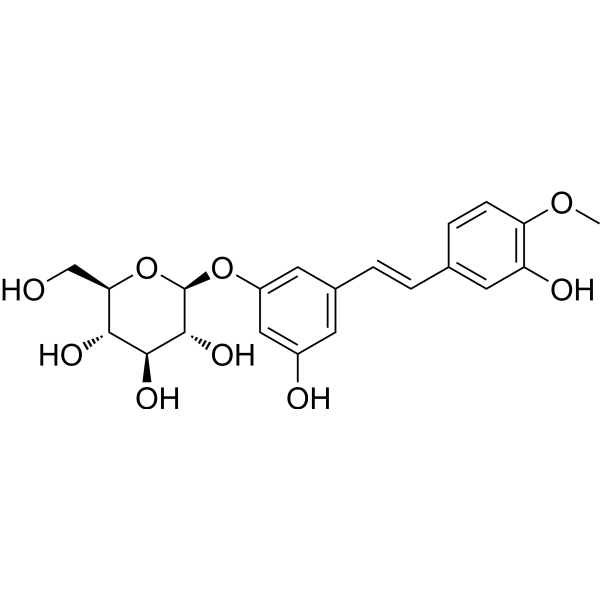
-
- HY-B0411A
-
|
R33812 monomaleate
|
|
|
|
Domperidone (R33812) monomaleate is an orally active and selective dopamine-2 receptor antagonist. Domperidone monomaleate acts as an antiemetic and a prokinetic agent through its effects on the chemoreceptor trigger zone and motor function of the stomach and small intestine .
|
-
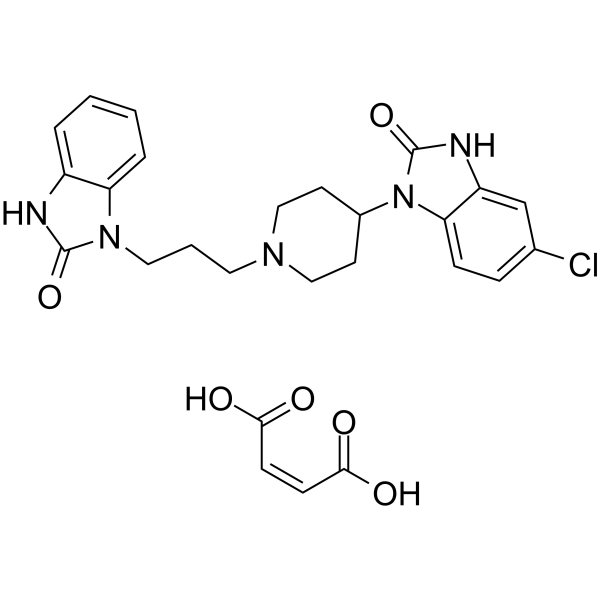
-
- HY-13662B
-
|
Dexlansoprazole
|
Proton Pump
|
Inflammation/Immunology
|
|
(R)-Lansoprazole is the R enantiomer of Lansoprazole, Lansoprazole (AG 1749) is an orally active proton pump inhibitor which prevents the stomach from producing acid. Lansoprazole (AG 1749) is a potent brain penetrant neutral sphingomyelinase (N-SMase) inhibitor (exosome inhibitor) .
|
-
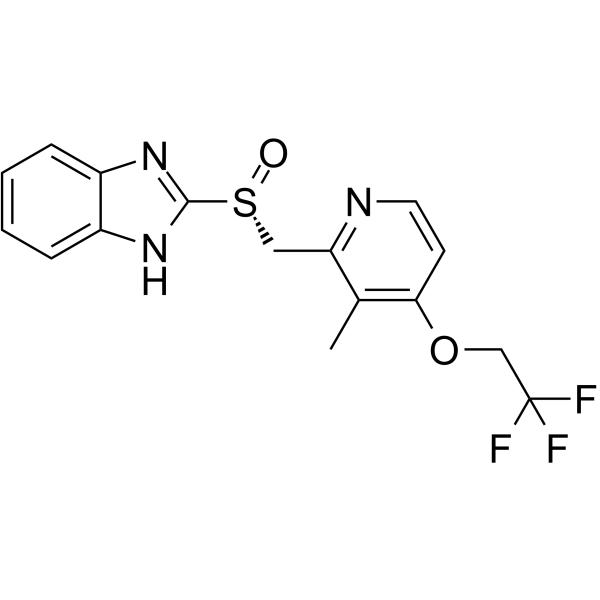
-
- HY-P1630
-
|
|
Bacterial
|
Infection
|
|
Buforin II, derived from buforin I, a protein isolated from the stomach of the Asian toad Bufo bufo gargarizans, is a potent antimicrobial peptide. Buforin II has antimicrobial activity against a broad spectrum of Gram-positive and Gram-negative bacteria .
|
-

-
- HY-P3680
-
-
![[Nle13]-Motilin](//file.medchemexpress.com/product_pic/hy-p3680.gif)
-
- HY-13662C
-
|
Levolansoprazole
|
Proton Pump
Phospholipase
Bacterial
|
Inflammation/Immunology
|
|
(S)-Lansoprazole (Levolansoprazole) is an isoform of Lansoprazole (HY-13662), which is an orally active proton pump inhibitor which prevents the stomach from producing acid. Lansoprazole (AG 1749) is a potent brain penetrant neutral sphingomyelinase (N-SMase) inhibitor (exosome inhibitor) .
|
-
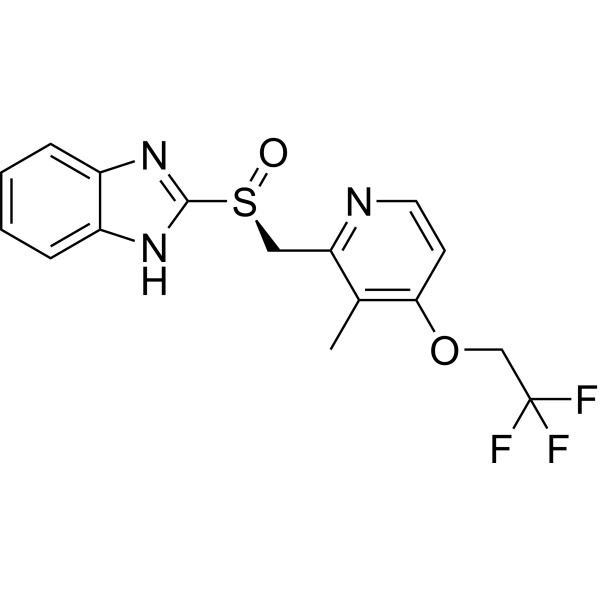
-
- HY-B0411S
-
|
|
Dopamine Receptor
|
Neurological Disease
|
|
Domperidone-d6 is the deuterium labeled Domperidone. Domperidone (R33812) is a selective dopamine-2 receptor antagonist. Domperidone acts as an antiemetic and a prokinetic agent through its effects on the chemoreceptor trigger zone and motor function of the stomach and small intestine[1][2].
|
-
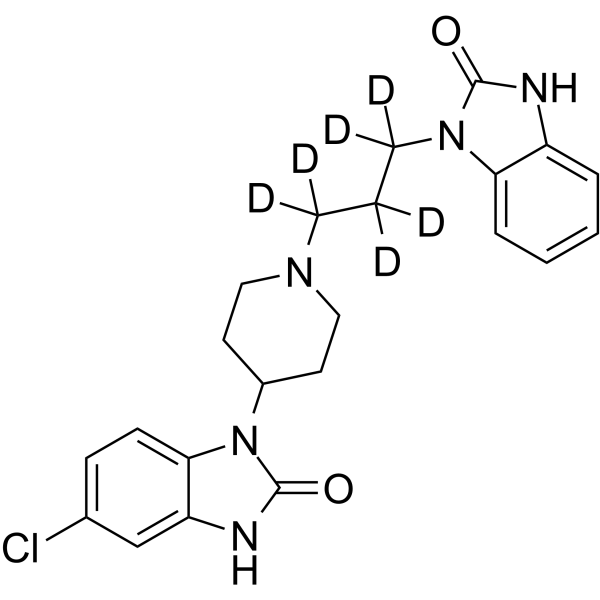
-
- HY-W671745
-
|
|
Others
|
Others
|
|
Entadamide A 2'-O-(6''-O-β-D-glucopyranosyl)-β-D-glucopyranoside (MFLNH I) (compound 5) can be isolated from the seed kernel of Entada rheedei. Entada rheedei is a medicinal plant from Thailand that is used to suppress stomach pain .
|
-

-
- HY-P3057
-
|
|
Neurotensin Receptor
|
Neurological Disease
|
|
[D-Trp11]-Neurotensin, an analogue of Neurotensin (NT), is a selective antagonist of NT in perfused rat hearts but behaves as a full agonist in guinea pig atria and rat stomach strips. [D-Trp11]-Neurotensin can inhibit NT-induced hypotension .
|
-
![[D-Trp11]-Neurotensin](//file.medchemexpress.com/product_pic/hy-p3057.gif)
-
- HY-B0550
-
|
Bismuth oxysalicylate; Bismuth(III) salicylate basic
|
PGE synthase
|
Neurological Disease
|
|
Bismuth Subsalicylate is a potent and orally active antacid and anti-diarrheal agent. Bismuth Subsalicylate reduces inflammation/irritation of stomach and intestinal lining through inhibition of prostaglandin synthesis in vivo . Bismuth Subsalicylate is widely used for the research of diarrheal disorders, including indigestion, diarrhoea, nausea, et al .
|
-
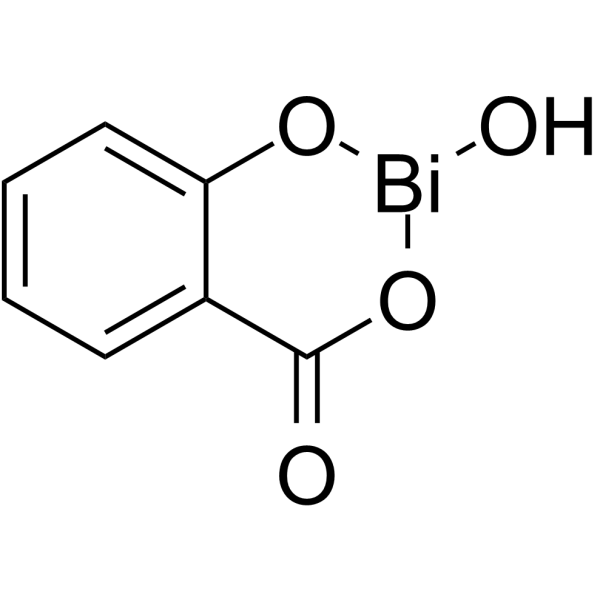
-
- HY-106840A
-
|
|
Cholecystokinin Receptor
|
Neurological Disease
Metabolic Disease
|
|
L-365260 hemihydrate is an orally active and selective antagonist of non-peptide gastrin and brain cholecystokinin receptor (CCK-B), with Kis of 1.9 nM and 2.0 nM, respectively. L-365260 hemihydrate interacts in a stereoselective and competitive manner with guinea pig stomach gastrin and brain CCK receptors .
|
-
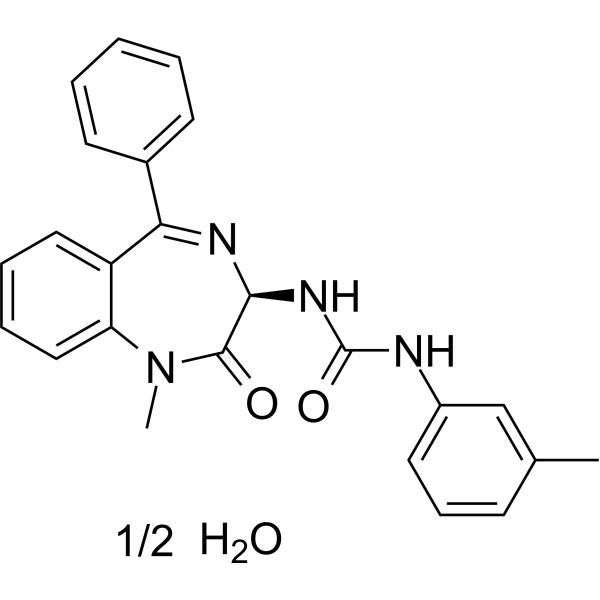
-
- HY-153907
-
|
|
Drug-Linker Conjugates for ADC
|
Cancer
|
|
SMP-88480 is an Antibody-Drug Conjugates (ADCs). SMP-88480 is stable in mouse, monkey and human plasma and has in vivo tumor inhibitory effects on ovarian cancer, gastric cancer, and breast cancer .
|
-
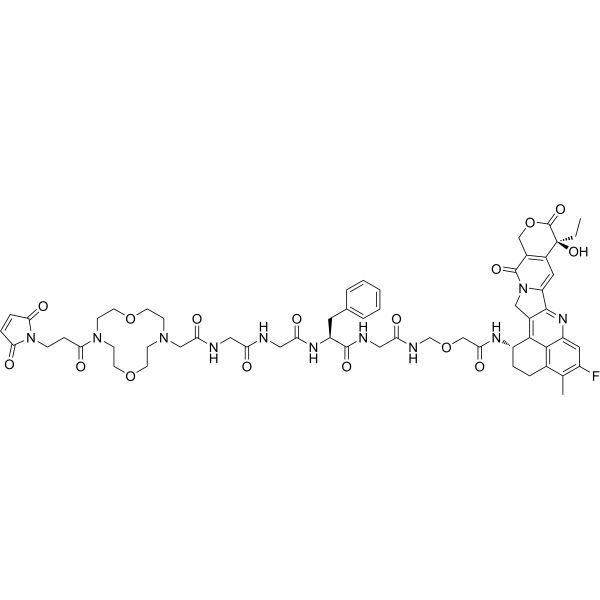
-
- HY-153908
-
|
|
Drug-Linker Conjugates for ADC
|
Cancer
|
|
SMP-93566 is a kind of antibody-drug conjugates (ADCs) with a low payload shedding rate and has in vivo tumor inhibitory effects on ovarian cancer, gastric cancer, and breast cancer .
|
-
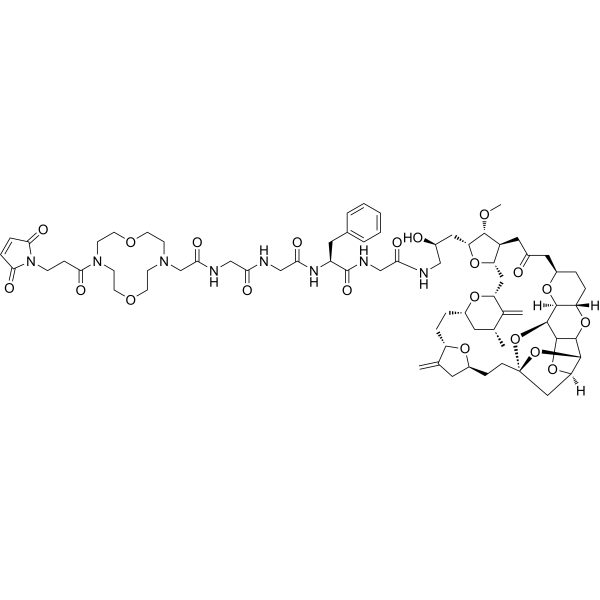
-
- HY-153909
-
|
|
Drug-Linker Conjugates for ADC
|
Cancer
|
|
SMP-33693 is a Drug-Linker Conjugate for ADC with a low payload shedding rate and has in vivo tumor inhibitory effects on ovarian cancer, gastric cancer, and breast cancer .
|
-

-
- HY-N3931
-
|
|
Others
|
Cardiovascular Disease
|
|
Gardneramine is an orally active alkaloid that acts like papaverine. Gardneramine has peripheral vascular diastolic effect, direct inhibition on myocardium and central inhibition. Gardneramine showed antihypertensive, vasodilatation and atrial inhibition effects in rabbit, dog and guinea pig models, respectively. Gardneramine also inhibits the movement of smooth muscle organs such as the stomach and intestines .
|
-
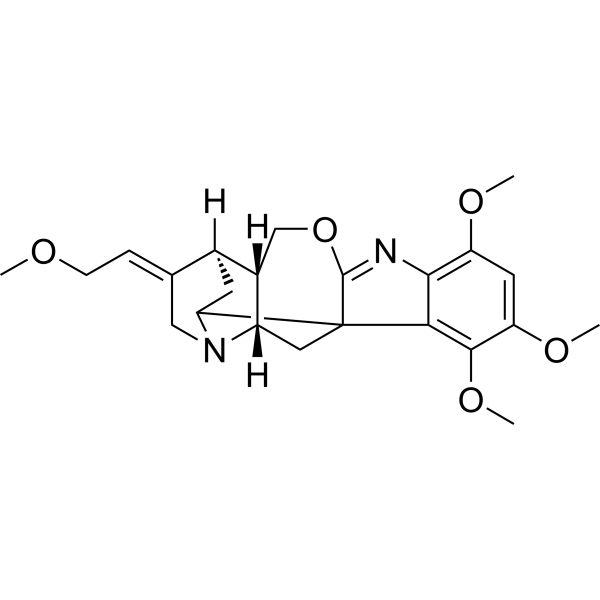
-
- HY-137273
-
|
|
Others
|
Others
|
|
Sucrose octasulfate is a component of sulfoaluminum. Sucrose octasulfate stimulates the release of somatostatin-like immunoreactivity (SLI) from the stomach by acting directly on D cells in the gastric mucosa. Sucrose octasulfate exerts its ulcer-healing effect by releasing endogenous gastric somatostatin Sucrose octasulfate can be used for anti-gastric ulcer research .
|
-
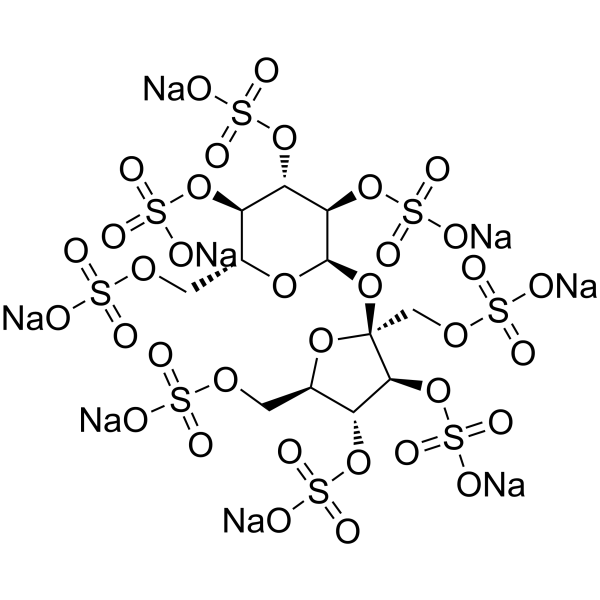
-
- HY-13625
-
|
L-749345; MK-826
|
Bacterial
Antibiotic
|
Infection
Cancer
|
|
Ertapenem sodium (L-749345) is a broad spectrum and long acting β-lactam antibiotic. Ertapenem sodium has a broad-spectrum anti-anaerobic activity against a variety of anaerobes with a mode MIC of 0.12 μg/mL. Ertapenem sodium can be used for the research of severe infections caused by bacteria in the skin, lungs, stomach, pelvis, and urinary tract .
|
-
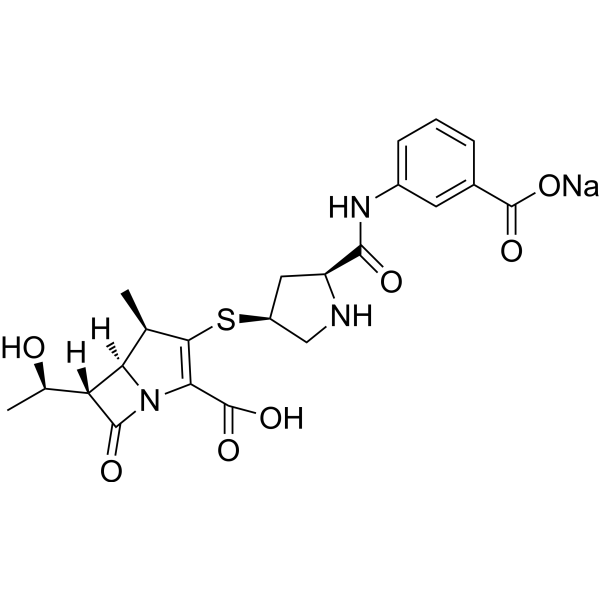
-
- HY-13662BS
-
|
Dexlansoprazole-d4
|
Isotope-Labeled Compounds
Proton Pump
|
Inflammation/Immunology
|
|
(R)-Lansoprazole-d4 is deuterium labeled (R)-Lansoprazole. (R)-Lansoprazole is the R enantiomer of Lansoprazole, Lansoprazole (AG 1749) is an orally active proton pump inhibitor which prevents the stomach from producing acid. Lansoprazole (AG 1749) is a potent brain penetrant neutral sphingomyelinase (N-SMase) inhibitor (exosome inhibitor)[1][2].
|
-

-
- HY-A0294
-
|
MK-0826
|
Antibiotic
Bacterial
|
Infection
|
|
Ertapenem (MK-0826) is a broad spectrum and long acting β-lactam antibiotic. Ertapenem has a broad-spectrum anti-anaerobic activity against a variety of anaerobes with a mode MIC of 0.12 μg/mL. Ertapenem can be used for the research of severe infections caused by bacteria in the skin, lungs, stomach, pelvis, and urinary tract .
|
-
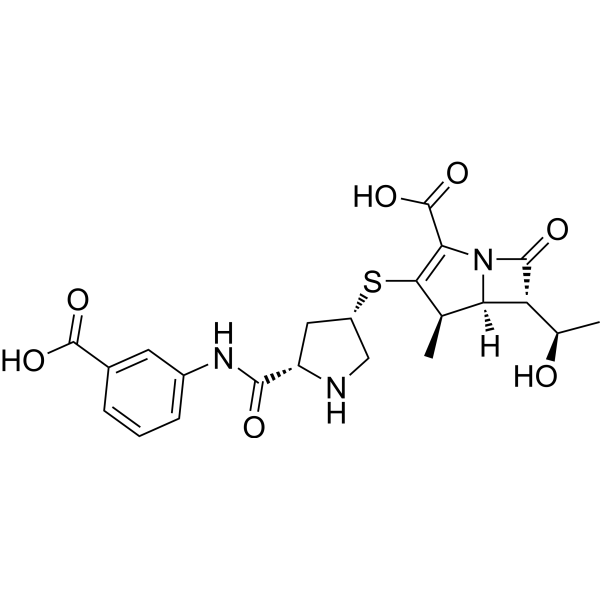
-
- HY-B1984S
-
|
4,4'-DDD-d8; p,p'-Dichlorodiphenyl dichloroethane-d8
|
Drug Metabolite
|
Others
|
|
p,p'-DDD-d8 is the deuterium labeled p,p'-DDD[1]. p,p'-DDD is a major metabolite of p,p'-DDT. p,p'-DDD occurs in the feces and livers of rats, that are given p,p'-DDT by stomach tube, but not of rats injected intraperitoneally with p,p'-DDT[2][3].
|
-
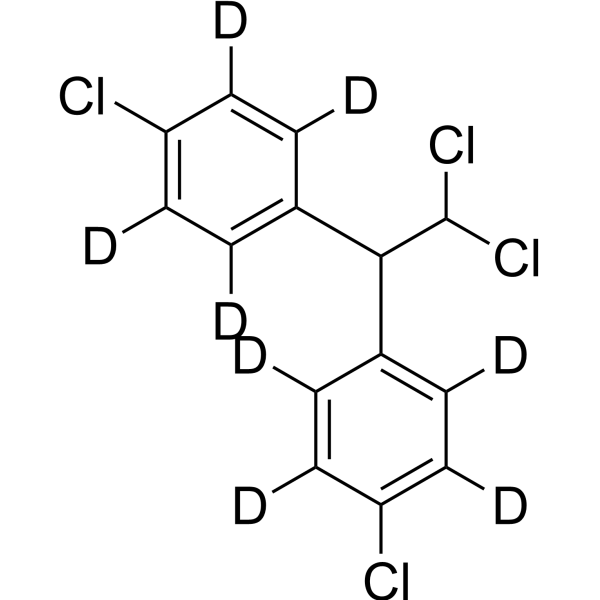
-
- HY-139342
-
|
|
CDK
|
Cancer
|
|
CDK7-IN-4 (compound I) is a potent CDK7 (Cyclin-dependent kinase 7) inhibitor. CDK7-IN-4 shows anticancer activity. CDK7-IN-4 inhibits the in vitro growth of cancer cell lines from a variety of histologies including colon , breast , lung , ovary and stomach , in a dose dependent manner .
|
-
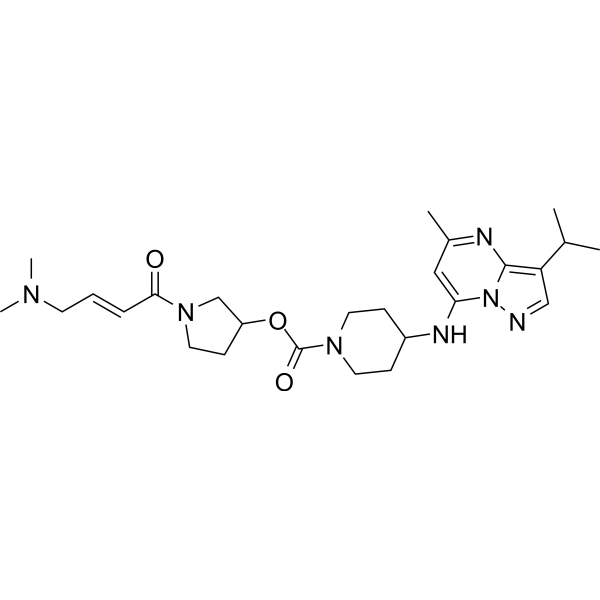
-
- HY-A0294A
-
|
MK-0826 disodium
|
Bacterial
Antibiotic
|
Infection
|
|
Ertapenem (MK-0826) disodium is a broad spectrum and long acting β-lactam antibiotic. Ertapenem disodium has a broad-spectrum anti-anaerobic activity against a variety of anaerobes with a mode MIC of 0.12 μg/mL. Ertapenem disodium can be used for the research of severe infections caused by bacteria in the skin, lungs, stomach, pelvis, and urinary tract .
|
-
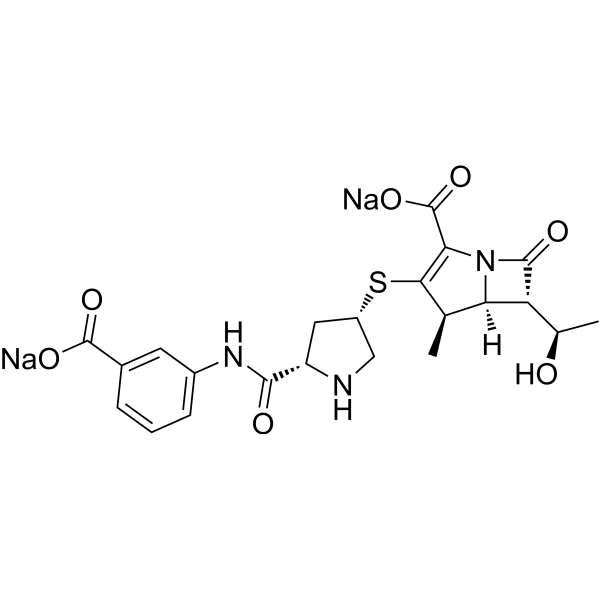
-
- HY-106840
-
|
|
Cholecystokinin Receptor
|
Neurological Disease
Metabolic Disease
|
|
L-365260 is an orally active and selective antagonist of non-peptide gastrin and brain cholecystokinin receptor (CCK-B), with Kis of 1.9 nM and 2.0 nM, respectively. L-365260 interacts in a stereoselective and competitive manner with guinea pig stomach gastrin and brain CCK receptors. L-365260 can enhance Morphine analgesia and prevents Morphine tolerance .
|
-
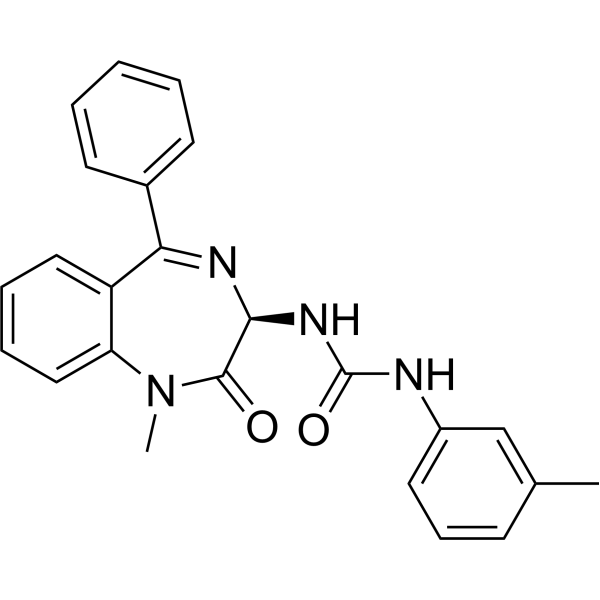
-
- HY-B0550R
-
|
Bismuth oxysalicylate (Standard); Bismuth(III) salicylate basic (Standard)
|
PGE synthase
|
Neurological Disease
|
|
Bismuth Subsalicylate (Standard) is the analytical standard of Bismuth Subsalicylate. This product is intended for research and analytical applications. Bismuth Subsalicylate is a potent and orally active antacid and anti-diarrheal agent. Bismuth Subsalicylate reduces inflammation/irritation of stomach and intestinal lining through inhibition of prostaglandin synthesis in vivo . Bismuth Subsalicylate is widely used for the research of diarrheal disorders, including indigestion, diarrhoea, nausea, et al .
|
-

- HY-N2551
-
|
S-Methylmethionine sulfonium chloride
|
Others
|
Inflammation/Immunology
|
|
Vitamin U (S-Methylmethionine sulfonium) chloride is an orally active anti-ulcer agent with antioxidant activity. Vitamin U inhibits adipocyte differentiation. Vitamin U promotes skin wound healing.Vitamin U can be used in the research of gastrointestinal ulceration .
|
-

- HY-122919
-
|
|
Others
|
Cancer
|
|
Momordicoside L is a Cucurbitane Triterpenoid, that can be isolated from the leaves of Momordica charantia. Momordicoside L shows anticancer activity .
|
-
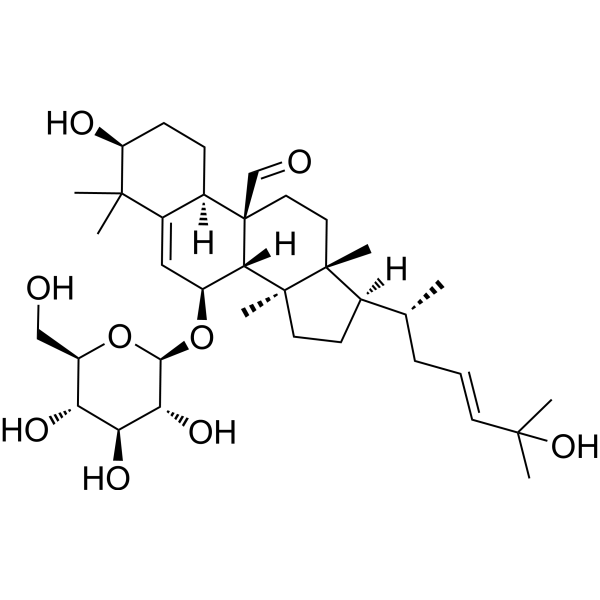
- HY-N0171
-
|
β-Sitosterol (purity>80%); 22,23-Dihydrostigmasterol (purity>80%)
|
Apoptosis
Endogenous Metabolite
|
Cardiovascular Disease
Inflammation/Immunology
Cancer
|
|
Beta-Sitosterol (purity>80%) includes β-sitosterol (≥80%), stigmasterol, campesterol and brassicasterol mainly. Beta-Sitosterol is a plant sterol. Beta-Sitosterol (purity>80%) interfere with multiple cell signaling pathways, including cell cycle, apoptosis, proliferation, survival, invasion, angiogenesis, metastasis and inflammation .
|
-
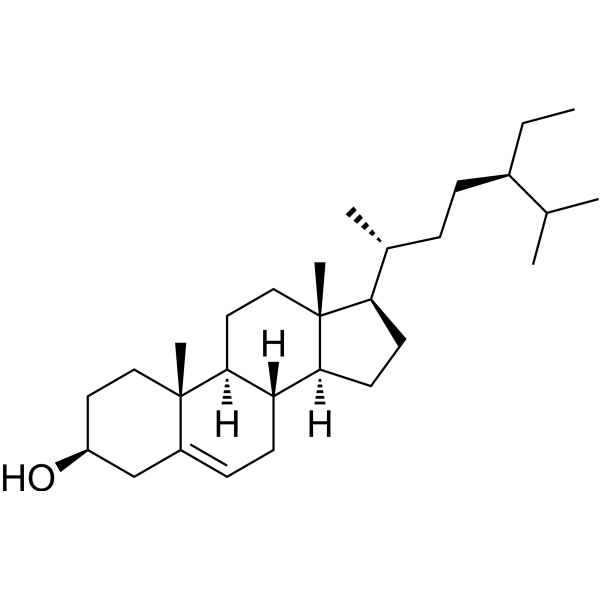
- HY-N0171A
-
-

- HY-B0900
-
|
Anise camphor; p-Propenylanisole; Isoestragole
|
Apoptosis
Fungal
Bacterial
MMP
NF-κB
|
Infection
Neurological Disease
Inflammation/Immunology
Cancer
|
|
Anethole is a type of orally active aromatic compound that is widely found in nature and used as a flavoring agent. Anethole possesses anticancer, anti-inflammatory, antioxidant, antibacterial, antifungal, anesthetic, estrogenic, central nervous system depressant, hypnotic, insecticidal, and gastroprotective effects. Anethole can be used in the study of oxidative stress-related skin diseases and prostate cancer .
|
-
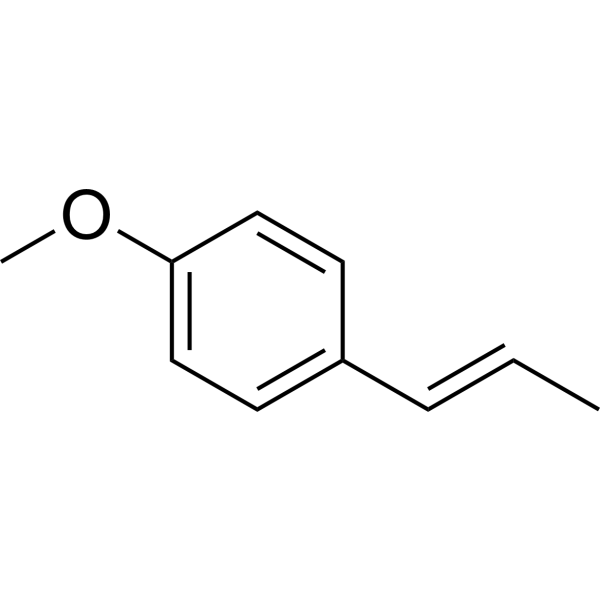
| Cat. No. |
Product Name |
Type |
-
- HY-P1635
-
|
EC 3.4.23.1
|
Biochemical Assay Reagents
|
|
Pepsin is the major pig and human gastric proteases, it is a pepsin-like minor gastric proteolytic enzymes. Pepsin contributes to proteolysis of food proteins in the vertebrate stomach .
|
-
- HY-W251598C
-
|
Sodium hydrogen carbonate for cell culture; Soda bicarbonate for cell culture
|
Buffer Reagents
|
|
Sodium bicarbonate, for cell culture, an inorganic salt, is neutral to slightly alkaline. And it is susceptible to moisture and decomposition in the air. Sodium bicarbonate is widely used in food, pharmaceutical, cosmetics and other fields, the main uses include buffer, seasoning, disinfectant, pharmaceutical and proton gradient regulator. Sodium bicarbonate is also commonly used as an antacid to suppress gastrointestinal disorders, neutralize stomach acid and reduce stomach discomfort.
|
-
- HY-P2810
-
|
EC 3.4.23.4
|
Biochemical Assay Reagents
|
|
Rennin, also known as Chymosin, is a pepsin-related proteolytic enzyme synthesized by cells in the stomach of certain animals that efficiently converts liquid milk into a semi-solid, allowing it to remain in the stomach for longer. The natural substrate of Rennin is K-casein, which is specifically cleaved at the peptide bond between amino acid residues 105 and 106, phenylalanine and methionine, and is widely used in cheese production .
|
-
- HY-Y0756
-
|
Sodium hydrogen carbonate
|
Biochemical Assay Reagents
|
|
Sodium bicarbonate, also known as baking soda, sodium bicarbonate, or sodium bicarbonate, is neutral to slightly alkaline. And it is susceptible to moisture and decomposition in the air. Sodium bicarbonate is widely used in food, pharmaceutical, cosmetics and other fields, the main uses include buffer, seasoning, disinfectant, pharmaceutical and proton gradient regulator. In the food industry, it is often used as a flour starter or leavening agent to make food swell up and become softer. Sodium bicarbonate is also commonly used as an antacid to suppress gastrointestinal disorders, neutralize stomach acid and reduce stomach discomfort.
|
-
- HY-E70077
-
|
|
Biochemical Assay Reagents
|
|
Penicillinase (from calf stomach) is an enzyme that degrades penicillin by hydrolyzing the cyclic amide bonds in the lactam ring of penicillin, which can inactivate penicillin. Penicillinase (from calf stomach) can be isolated from penicillin resistant strains. Penicillinase (from calf stomach) has potential application as a marker for steroid hormone enzyme linked immunosorbent assay .
|
| Cat. No. |
Product Name |
Target |
Research Area |
-
- HY-P1097
-
-
- HY-P1630
-
|
|
Bacterial
|
Infection
|
|
Buforin II, derived from buforin I, a protein isolated from the stomach of the Asian toad Bufo bufo gargarizans, is a potent antimicrobial peptide. Buforin II has antimicrobial activity against a broad spectrum of Gram-positive and Gram-negative bacteria .
|
-
- HY-P3631
-
|
|
Peptides
|
Neurological Disease
|
|
SALMF amide 2, a neuropeptide S2 from the starfish Asterias rubens, is involved in the regulation of eversion of the cardiac stomach in starfish .
|
-
- HY-P3680
-
-
- HY-P3057
-
|
|
Neurotensin Receptor
|
Neurological Disease
|
|
[D-Trp11]-Neurotensin, an analogue of Neurotensin (NT), is a selective antagonist of NT in perfused rat hearts but behaves as a full agonist in guinea pig atria and rat stomach strips. [D-Trp11]-Neurotensin can inhibit NT-induced hypotension .
|
| Cat. No. |
Product Name |
Category |
Target |
Chemical Structure |
-
- HY-N0671
-
-

-
- HY-N0925
-
-

-
- HY-N12121
-
-

-
- HY-N9183
-
-

-
- HY-N0671R
-
-

-
- HY-W671745
-
-

-
- HY-N3931
-
-

-
- HY-N2551
-
|
S-Methylmethionine sulfonium chloride
|
Plants
Compositae
|
Others
|
|
Vitamin U (S-Methylmethionine sulfonium) chloride is an orally active anti-ulcer agent with antioxidant activity. Vitamin U inhibits adipocyte differentiation. Vitamin U promotes skin wound healing.Vitamin U can be used in the research of gastrointestinal ulceration .
|
-

-
- HY-122919
-
-

-
- HY-N0171
-
|
β-Sitosterol (purity>80%); 22,23-Dihydrostigmasterol (purity>80%)
|
Cardiovascular Disease
Structural Classification
other families
Classification of Application Fields
Leguminosae
Source classification
Plants
Endogenous metabolite
Inflammation/Immunology
Disease Research Fields
Glycyrrhiza uralensis Fisch.
Steroids
|
Apoptosis
Endogenous Metabolite
|
|
Beta-Sitosterol (purity>80%) includes β-sitosterol (≥80%), stigmasterol, campesterol and brassicasterol mainly. Beta-Sitosterol is a plant sterol. Beta-Sitosterol (purity>80%) interfere with multiple cell signaling pathways, including cell cycle, apoptosis, proliferation, survival, invasion, angiogenesis, metastasis and inflammation .
|
-

-
- HY-N0171A
-
-

-
- HY-B0900
-
|
Anise camphor; p-Propenylanisole; Isoestragole
|
Structural Classification
Classification of Application Fields
Callicarpa maingayi King & Gamble
Source classification
Plants
Microorganisms
Simple Phenylpropanols
Leguminosae
Phenylpropanoids
Umbelliferae
Glycyrrhiza uralensis Fisch.
Disease Research Fields
Cancer
|
Apoptosis
Fungal
Bacterial
MMP
NF-κB
|
|
Anethole is a type of orally active aromatic compound that is widely found in nature and used as a flavoring agent. Anethole possesses anticancer, anti-inflammatory, antioxidant, antibacterial, antifungal, anesthetic, estrogenic, central nervous system depressant, hypnotic, insecticidal, and gastroprotective effects. Anethole can be used in the study of oxidative stress-related skin diseases and prostate cancer .
|
-

| Cat. No. |
Product Name |
Chemical Structure |
-
- HY-B0310S
-
|
|
|
Nizatidine-d3 is the deuterium labeled Nizatidine. Nizatidine is a potent and orally active histamine H2 receptor antagonist, can be used for the research of stomach and intestines ulcers. Nizatidine works by decreasing the secretion of gastric acid the stomach makes and prevent ulcers from coming back after they have healed in animal models[1].
|
-

-
- HY-13662S
-
|
|
|
Lansoprazole-d4 is a deuterium labeled Lansoprazole. Lansoprazole is a proton pump inhibitor which prevents the stomach from producing acid[1].
|
-

-
- HY-B1188S
-
|
|
|
Propantheline-d3 (bromide) is the deuterium labeled Propantheline bromide. Propantheline bromide is an antimuscarinic agent, used for the treatment of hyperhidrosis, cramps or spasms of the stomach, intestines or bladder, and enuresis.
|
-

-
- HY-13662BS
-
|
|
|
(R)-Lansoprazole-d4 is deuterium labeled (R)-Lansoprazole. (R)-Lansoprazole is the R enantiomer of Lansoprazole, Lansoprazole (AG 1749) is an orally active proton pump inhibitor which prevents the stomach from producing acid. Lansoprazole (AG 1749) is a potent brain penetrant neutral sphingomyelinase (N-SMase) inhibitor (exosome inhibitor)[1][2].
|
-

-
- HY-B0411S
-
|
|
|
Domperidone-d6 is the deuterium labeled Domperidone. Domperidone (R33812) is a selective dopamine-2 receptor antagonist. Domperidone acts as an antiemetic and a prokinetic agent through its effects on the chemoreceptor trigger zone and motor function of the stomach and small intestine[1][2].
|
-

-
- HY-B1984S
-
|
|
|
p,p'-DDD-d8 is the deuterium labeled p,p'-DDD[1]. p,p'-DDD is a major metabolite of p,p'-DDT. p,p'-DDD occurs in the feces and livers of rats, that are given p,p'-DDT by stomach tube, but not of rats injected intraperitoneally with p,p'-DDT[2][3].
|
-

Your information is safe with us. * Required Fields.
Inquiry Information
- Product Name:
- Cat. No.:
- Quantity:
- MCE Japan Authorized Agent:




































![[Nle13]-Motilin](http://file.medchemexpress.com/product_pic/hy-p3680.gif)



![[D-Trp11]-Neurotensin](http://file.medchemexpress.com/product_pic/hy-p3057.gif)






















